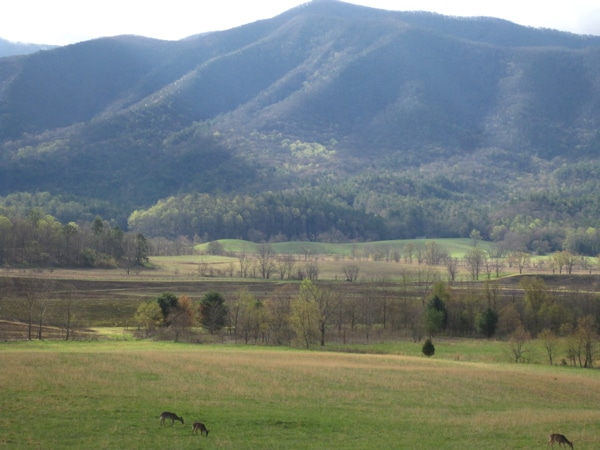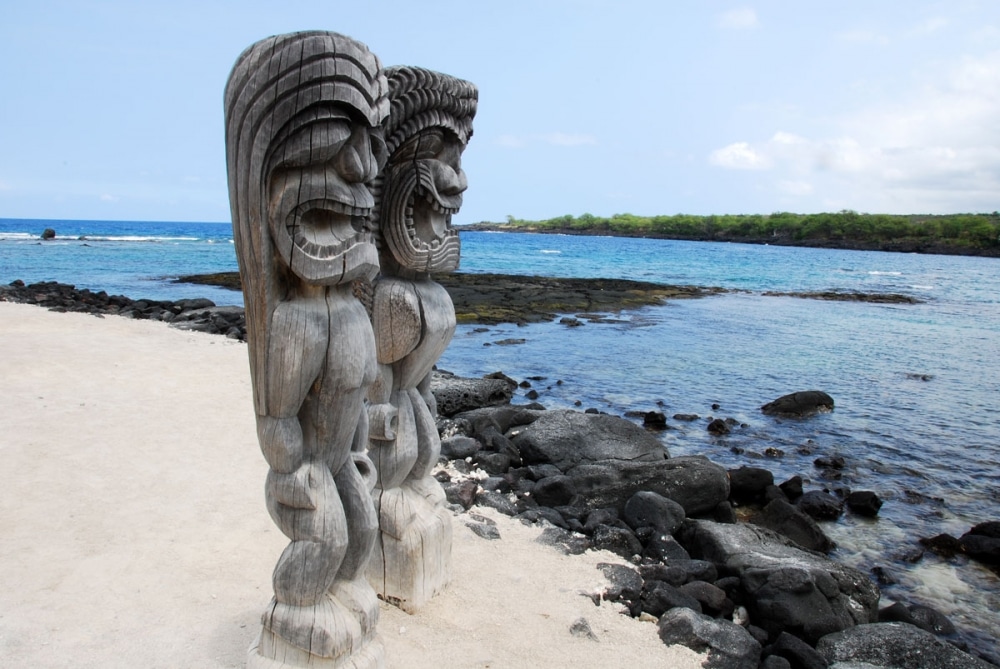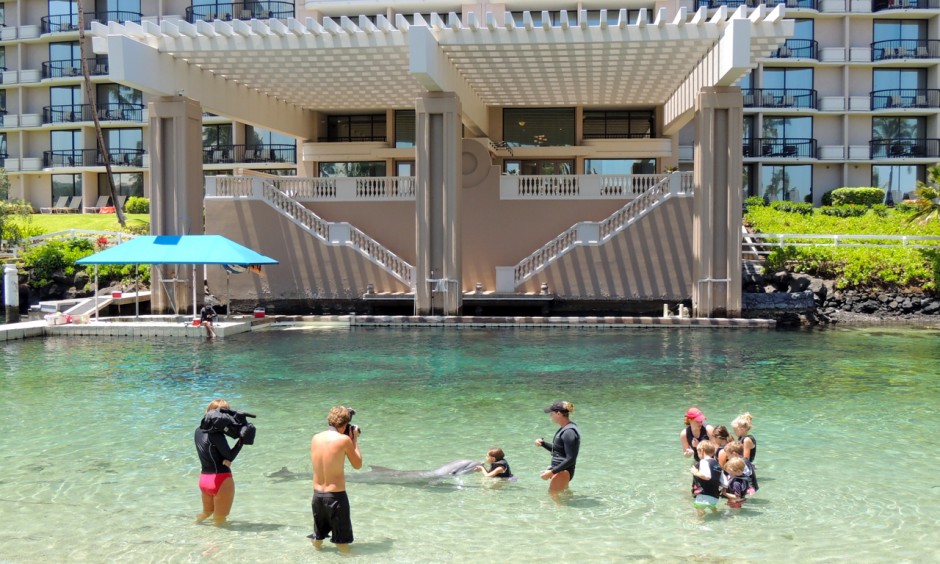While visiting Great Smoky Mountains National Park, we spent a day at Cades Cove. Twenty-seven miles west of Gatlinburg, Tennessee and once a thriving farming community, it is now the park’s major tourist attraction, receiving more than two million visitors each year. We enjoyed the trip between the town and the Cove, on a narrow road, winding our way along wide mountain streams, often between steep, tree-covered hills. As we got closer to our destination, our excitement grew as we anticipated several hours exploring the remnants of the old village and taking a hike to Abrams Falls.
When we arrived at Cades Cove, we found ourselves on a one-way, eleven-mile loop road. We came upon some gorgeous open fields surrounded by mountains, and we stopped to photograph a small herd of deer. We wondered why these fields were here, fenced in and some burned, seemingly prepared for plowing. The scene looked too pristine, almost staged. Later we learned that, although no one still lives in the Cove, a few families pay a fee to the park for the privilege of doing some farming.
Something struck us as peculiar about this landscape. The usual policy of the National Park Service in the Smokies has been to let formerly farmed areas revert to nature, and we saw many examples in other parts of the park. Why wasn’t this the case in Cades Cove? We returned to our car and continued on the road, noticing signs along the way, directing motorists toward one or another old but restored structure: a cabin, a church, a cemetery, a grain mill. Apparently, nothing had been left in its original state.
We began to feel disappointed and angry. Cleared fields, “farmers” paying to till the soil, restored buildings? This was looking like a movie set. Traffic was picking up, and we envisioned a long, slow drive, our irritation rising as we passed more and more tourist venues. Fortunately, we came to the unpaved road that led to the Abrams Falls trailhead. We put on our backpacks and began to hike. Soon we were in our element. The trail overlooks a stream surpassing in its beauty, meandering its way to the falls. Along with other hikers, we enjoyed the wildflowers, singing birds, and the wonderful waterfall, which pours into a large and inviting pool. We talked to some hikers and for a couple of hours forgot about the loop road.
When we got back in our car again, traffic was much heavier and slower. At every homestead, church, and barn, tourists snapped pictures from their automobile windows. We got behind a car from Louisiana and moved at a crawl for more than an hour, the driver appearing to revel at the long line of vehicles behind him. I got so mad that I began to mumble that I ought to get out and douse him with bear spray. At last, the road ended, and we returned to the highway back to Gatlinburg, talking about what we had seen. I knew that I had to find out something about the history of Cades Cove, to discover how a town dies and becomes a tourist attraction.
Before white settlers came to the Cove, Cherokee Indians used it as a summer hunting ground, and a trail they traversed from North Carolina through Tennessee crossed the area. A series of treaties forced upon them by a U.S. government intent on increasing its territory and whites wanting access to land, compelled the Indians to relinquish their historic home, most of them eventually leaving under direct military command.
The first permanent white settlers arrived in 1818 and many more soon followed, attracted by the wide, relatively flat, valley, which had rich soil for farming, trees for buildings and heat, abundant water sources, and plentiful fish and game. It is, without doubt, a place of great beauty, surrounded by mountains and laced with clear, sparkling streams. By 1850, nearly 700 people called the Cove home. They farmed and produced nearly all of what they needed to live, trading for dry goods and other necessities in a nearby town.
Contrary to the stereotype we often have of mountain men and women, those who lived in Cades Cove were not primitive, isolated, backwoods hillbillies. They had a post office in 1833; roads connected them to the outside world by the 1850s; and telephone service began in the 1890s. They also knew about and participated in the national politics of the day. Most were strongly opposed to slavery, and abolitionist preachers often gave sermons in Cove churches. A stop on the Underground Railroad helped escaping slaves get to the North and freedom.
When the national park was being conceived in the late 1920s, the inhabitants of the Cove were told that their lands would not be part of it. Soon, however, the federal government reversed itself, and the residents were subjected to eviction by eminent domain. They strenuously fought against their displacement, but they ultimately lost. For many years, into the 1960s, they continued to use their churches, resisting the power of the National Park Service.
As we learned this, we were saddened by the knowledge that for more than one hundred years, people lived in Cades Cove, supporting themselves through their labors and developing a strong community. Then they were kicked out. Why was this necessary? The entire area comprises only about 2,000 of the park’s 500,000 acres, and it certainly was not essential for the park’s existence. The Cove’s farmers had deforested some of the land, but surely this problem could have been addressed without compelling them to leave.
We can’t know, of course, what would have happened to Cade’s Cove had it not become part of the national park. Maybe the landowners would have sold to developers. Maybe one or two of the most successful farmers would have bought ought the others, and these would have begun to mass produce chickens or hogs. But would these have been worse than creating a make-believe setting for tourists in cars, polluting the air as they drive bumper to bumper at five miles per hour?
Among the barns, houses, grain mills, and churches built by the residents of Cades Cove, the Park Service tore down the most modern ones, which were typical of the way the farmers were living in the 1920s and 1930s when they were forced out. Left were the oldest buildings, such as log cabins and primitive churches, which park employees maintain. Public funds are used to keep buildings in better shape now than they were when people lived there. What this means is that visitors are given a false impression of how the people of Cades Cove improved the ways in which they lived. We can’t help but believe that this was intentional. Tourists peer at the fields and restored buildings and think that they have a window onto the past, onto how these people lived an unchanging, primitive, but heroic life. The stuff of legends—and movies.
But this is a lie. What is missing are the things that matter most: the ups and downs of daily life in the Cove, the richness and sadness of life there, the skills the farm families developed, the zeal of their religious beliefs, the hardness of their bodies, the generosity of their spirits, and the fierceness with which they tried to keep their land. These have been lost, and we are the poorer for it.
What the Park Service has done at Cades Cove is idealize and falsify the past. What lessons can we take from such a whitewashing of our heritage? It would have been better had the government simply allowed every structure to decay and every field to become full of tall trees. The progeny of the pioneers would still have returned to plant flowers on the old gravestones, and we could have wondered what life was like those many years ago.







I wonder why this experience made you so angry. You ARE aware, aren’t you, that no “historical re-creation,” of any location or situation, could possibly be accurate? Not only do we lack enough data to construct such a place with any degree of authenticity, we would probably resist re-creating a town with slavery, 50% child mortality, a near-total lack of what we consider basic creature comforts (sanitation, adequate heating and lighting), and so forth–all of which would have been salient features of rural communities (with the exception of slavery) well into the 20th century.
They have probably saved and restored the oldest buildings because there wouldn’t be much interest in a restored say, 1930s village. In any case, whatever they created would be a fiction. I don’t think that anyone with an ounce of common sense or of brain matter would expect anything but that. Only the densest of tourists that go to places like Williamsburg would think that they are authentic reconstructions–for one thing, life 100 years ago or more was pretty filthy compared to today.
Perhaps the silliest of your premises is that if everything had just been allowed to fall down and decay, that would somehow have been a superior way to educate visitors about the past. How could a bunch of ruins help people understand what life used to be like?
The truth is that NO ONE knows exactly what life was like in Cades Cove in 1850, and any reconstruction of life there is at best an educated guess. Complaining about such a reconstruction’s inaccuracy beggars the point.
The simple truth is that no one is forced to drive that horrid, horrid road that snakes through the reconstructed village, so presumably, people are getting some kind of enjoyment out of doing so. I realize that the Marxist point of view is that all that land belongs to the state and should be turned into a tank factory or something, and all the park employees should be put into prison camps for not adequately serving the collective good. However, our country has not yet adopted the ineffable wisdom, the shining light of the great Marx and his human-hive social model. Would that every single resource of this great nation were throw into the great collective and that no such resources were allocated toward bourgeois amusement or enjoyment (we of the collective aren’t entitled to happiness or leisure–it’s wasteful).